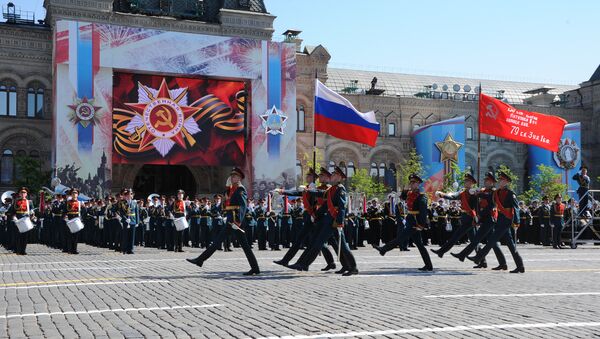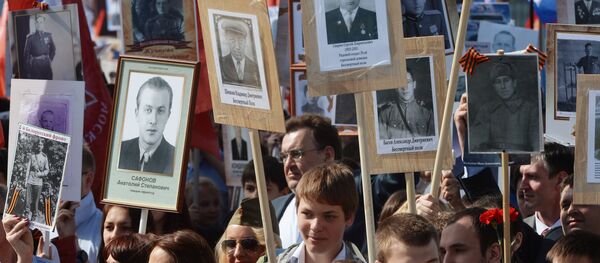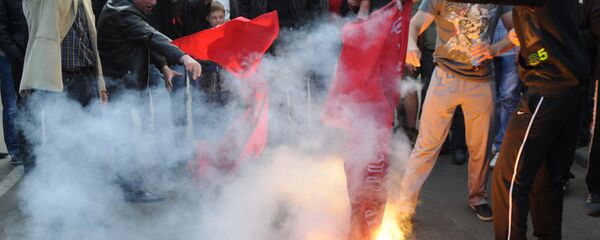MOSCOW (Sputnik) – The Great Patriotic War was a crucial part of World War II (1939-1945). It began on June 22, 1941, when Germany launched an attack on the Soviet Union in violation of all prevailing treaties. Germany's allies in the war were Romania, Italy, Slovakia, which joined the war on June 23, Finland (June 25), Hungary (June 27) and Norway (August 16).
The Blitzkrieg, or the "lightning war" that was planned by Germany to defeat the Soviet Union within a few months, went awry almost immediately in 1941. The staunch defense of Leningrad (now St. Petersburg), the Arctic region, Kiev, Odesa and Sevastopol, as well as the battle of Smolensk, rendered the Blitzkrieg plans obsolete.
The Soviet army courageously stood its ground, eventually pushing the enemy back, defeating Nazi troops near Moscow, Stalingrad (now Volgograd) and Leningrad, as well as in the Caucasus, in the Battle of Kursk, in Ukraine on the right (West) bank of the Dnieper River, in Belarus, and during the Jassy-Kishinev and Vistula-Oder Offensives and the Battle of Berlin.
The Soviet Union won the war but the victory exacted a huge toll on the population, with nearly every Soviet family losing loved ones. Germany signed an Act of Unconditional Surrender in a suburb of Berlin in the late evening of May 8, 1945 (already May 9 according to Moscow Time).
It is for this reason that Victory in Europe Day (VE Day) is marked on May 8, while the Soviet Union and now Russia marks Victory Day on May 9.
On May 8, 1945, the Presidium of the Soviet Union's Supreme Soviet issued a decree according to which May 9 would be marked as "the day of national celebrations of the victorious end of the Great Patriotic War of Soviet people against Nazi occupiers and the Red Army's historical victories that led to the routing of Hitler Germany and its unconditional surrender".
On May 9, 1945, people across the Soviet Union celebrated the Victory Day with parades, dancing and singing. Amateur groups, popular film and theater actors and orchestras performed in squares and parks. That evening, people listened to a radio address by Stalin followed by an impressive display of fireworks that consisted of 30 shots from 1,000 artillery guns. Afterwards, dozens of aircraft fired rockets that formed garlands of multicolored lights over Moscow. People in many squares across the country lit sparklers.
In December 1947, the Supreme Soviet's Presidium decreed that May 9 should be a working day, effectively canceling the Victory Day celebrations in 1948. It was only on April 26, 1965, twenty years after the victory, that they were resumed under Nikita Khrushchev. The Presidium of the Supreme Soviet, the central governing body of the USSR, made it a non-working public holiday and established a special jubilee medal.
The May 9 military parades were later held in many other Soviet cities. Until 1995, military parades in Moscow's Red Square were only held in jubilee years – 1965, 1985 and 1990. The May 9, 1995 military parade was designed to resemble the historic Victory Parade of 1945 and featured war veterans, home front workers and Moscow Garrison troops. The Victory Banner was carried in front of the troops.
The federal law On Immortalizing the Victory of the Soviet People in the Great Patriotic War of 1941-1945, signed on May 19, 1995, proclaimed May 9 a national holiday and that Victory Day was to be celebrated with military parades and artillery salutes.
Starting in 1996, military parades were held in Red Square every year but it would be in 2008 that military vehicles took part in the parade in the post-Soviet history era.
The Saint George's Ribbon campaign was first held several days before the 2005 Victory Day to remind young people of the importance of the holiday. Orange ribbons with three black stripes have become a reminder of the Soviet people's victory in the Great Patriotic War and of the appreciation felt for the veterans who defeated Nazism. The campaign's motto is "We remember, we are proud!" The campaign has been held throughout Russia as well as in many former Soviet republics. In the past few years, it has been extended to Europe and North America.
It has become a tradition to hold meetings with war veterans, other events and concerts during Victory Day celebrations. Wreath and flower laying ceremonies are held at monuments to war victims and at common graves. Memorial services are held in churches, synagogues and mosques across Russia. Starting in 1965, radio and television channels conduct a minute of silence on May 9.
The 2015 Victory Day parade in Moscow was attended by 27 foreign leaders, including presidents of the BRICS group of emerging economies, former Soviet Republics-turned-CIS states, as well as some Asian and European countries, and UN Secretary-General Ban Ki-moon.
In 2016, the May 9 parades all across Russia honor the 71st anniversary of the victory over Nazi Germany. The parade in Moscow alone involved about 10,000 servicemen, 135 units of military equipment and 71 aircraft.







